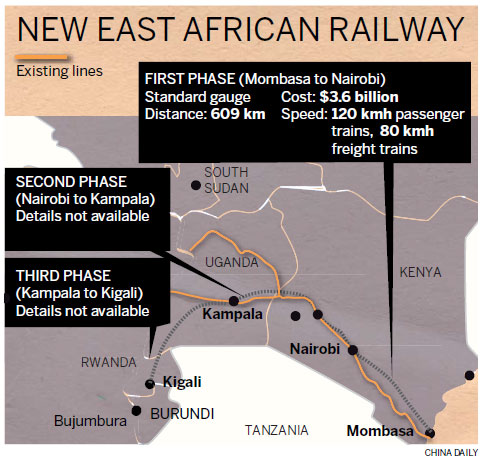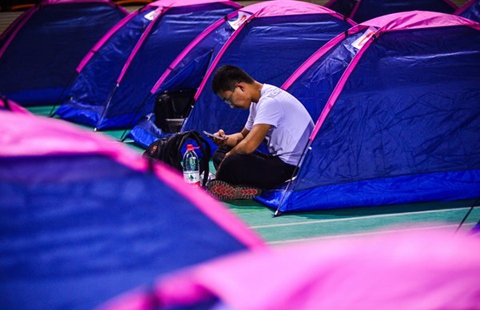
Work is set to start on a chinese-built line connecting Kenya, Uganda and Rwanda
Kenya is set to seal its place as the regional transport hub with the beginning of construction work on a new standard-gauge railway line this month.
President Uhuru Kenyatta performed the ground breaking ceremony in Mombasa in November, but work did not begin as two parliamentary committees investigated whether there was a breach in the procurement process as claimed by a legislator, Alfred Keter.
The project was given a clean bill of health early this year, and work is set to begin at any time. The railway is expected to pass through Nairobi in its first phase en route to Kampala in Uganda before ending in Kigali, Rwanda. The total track distance inside Kenya between Mombasa and Malaba, on the border with Uganda, would be 1,300 kilometers.
In May, Henry Rotich, Kenya's cabinet secretary for treasury, and the president of China Exim Bank, Li Ruogu, signed an agreement under which Beijing would fund the project. This was during Chinese Premier Li Keqiang's visit to Kenya. Presidents Kenyatta, Salva Kiir Mayardit (South Sudan), Paul Kagame (Rwanda), Yoweri Museveni (Uganda) and Li witnessed the signing of the agreement in Nairobi.
The first phase, which is the section between Mombasa and Nairobi, would cover 609 kilometers. The route is to have seven passenger stations, at Mombasa, Mariakani, Voi, Mtito Andei, Sultan Hamud, Athi River and finally Nairobi. The second phase would link the line to the border town of Malaba with a branch line to Kisumu. In the final phase a line would be built between Malaba and Kampala, Uganda.
Passenger trains, with a maximum carrying capacity of 960 people, will be capable of attaining a top speed of 120 kmh. This means it would take just under four and a half hours to travel from the port city of Mombasa to the capital, Nairobi. Freight locomotives would be able to carry 4,000 tons and would reach speeds of 80 kmh and will take eight hours to cover the distance. The line would also be able to carry double-stacked containers that can be electrified later.
The project is expected to cost $3.6 billion. This covers the 56 diesel locomotives and 1,620 wagons that China will supply. China Exim Bank will finance 90 percent of the cost, and the Kenyan government the rest.
The first phase is forecast to take three and a half years to complete. The cost of engineering and procurement for the remaining phases to Uganda and finally Kigali are yet to be established since a consulting firm is carrying out the initial routing for the line.
In June, Rwanda and Uganda hit the ground running when they signed a contract with German consulting firm Gauff Ingenieure Consultancy Services to carry out the initial engineering design of the standard-gauge line between Kampala and Kigali. The two countries will share the $83 million fee for the design, with Uganda paying the lion's share. Most of the line will be in Uganda.
Last year, the Kenyan government put measures in place to raise funds for the project. The railway development levy, a tax on all imports into the country, was introduced as a way of raising money for the project.
The project is the largest ever for the country and is set to link it with its East African neighbors. The expected total cost of $8.1 billion will be shared by the three countries. The presence of the three East African heads of state during the signing ceremony reaffirms the commitment they have in meeting the final goal to connect the countries by rail and enable the easy flow of goods from and to the port of Mombasa.
China Road and Bridge Company is responsible for delivering this flagship project of Kenya's Vision 2030, a government development program. Last month, the managing director of Kenya Railways announced that China Road and Bridge will bring in 5,000 Chinese workers to work with locals in building the railway line.
Speaking in Beijing, Lu Shaye, director-general of the Department of African Affairs, Ministry of Foreign Affairs, says the multibillion project is a government-to-government arrangement.
The project will benefit all Kenyans and East Africans, including those opposed to it, he says. Various interests groups had opposed the way the Kenyan government had handled the project.
Lu, the former Chinese ambassador to Senegal, reiterated his government's commitment to the economic growth of African countries through strengthened China-Africa relations.
"China is very much interested in the growth and development of African countries, including Kenya."
It has been more than 50 years since Kenya last undertook a project of the magnitude as that of the new railway. The existing line is more than 100 years old and highly inefficient.
The standard-gauge railway is expected to haul at least 28 million tons of cargo between the East African countries annually. Tanzania is also upgrading its central line to standard gauge, and it is expected to carry at least 35 million tons of cargo to Rwanda, Uganda and Burundi once complete.
Du Fei, vice-president of China Road and Bridge Corporation, said in Beijing recently that the company has undertaken many projects in Kenya since establishing an office in Nairobi in 1984.
"We have undertaken 23 road projects totaling about 1,200 km, including the busy Mombasa-Nairobi highway, which is now referred to as China Road."
CRBC is also responsible for building two major bypasses in Nairobi, and work is 90 percent complete, he said.
Last year, President Kenyatta led President Museveni of Uganda and his counterpart Kagame of Rwanda in commissioning a new berth at Kilindini Harbor in Mombasa.
The expansion was undertaken by CRBC from 2011 at a cost of $82 million. This was the first upgrading of the port since 1980.
Kenya and Uganda are already linked with the existing Uganda Railway, known as the Lunatic Express railway from Mombasa to Tororo in Uganda. However, the section between Kisumu in Kenya to Tororo in Uganda has been out of service for 34 years because it has been in dire need of repair.
The meter-gauge single track was built in 1896 by the British government, and was nicknamed the Lunatic Express because out of the 32,000 laborers, mainly from India, at least 2,400 died during construction. Most of the survivors returned to India once the line was completed, and the rest were founders of the East Africa's Indian population.
Rwanda and Burundi, the two landlocked neighboring countries, will be looking to benefit the most from the project because they have no existing railways.
For China Daily
|
Lu Shaye (left), director-general of the Department of African Affairs of the Ministry of Foreign Affairs, and Du Fei, vice-president of China Road and Bridge Corporation, say Kenya's Vision 2030 will benefit all Kenyans and other East Africans. Photos Provided to China Daily |

(China Daily Africa Weekly 09/05/2014 page8)








